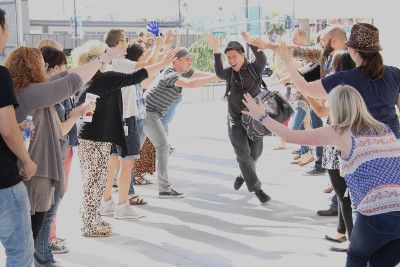This week’s article is a guest post from Maggie Hsu, an Advisor at Zappos.com. Zappos.com is a leading online retailer headquartered in Las Vegas specializing in shoes and clothing. Previously, Maggie was Vice President and Chief of Staff at Downtown Project. Downtown Project is aiding in the revitalization of Downtown Las Vegas and encompasses a collection of over 300 investments and operations across small business, technology and real estate. Maggie holds undergraduate and MBA degrees from Harvard University.
Some of the most important discoveries have come from seemingly “serendipitous” encounters. For example, Jim Watson and Francis Crick, two biologists, couldn’t figure out that DNA had a double helix structure until they saw an X-ray taken by Rosalind Franklin, a chemist.
Why is serendipity so important? We might laughingly cite a serendipitous conversation or encounter that helped us reframe a problem or come to an insight, but that coming together of disparate viewpoints is critical to helping us make progress in many different ways. You might have expertise in a certain area, but breakthrough innovation comes when you run into someone who has that piece of input you hadn’t thought about, read an unrelated article, or watch an unrelated TV segment.
Individuals who are able to make these non-linear connections benefit tremendously from that skill. Ronald Burt, a sociologist at the University of Chicago, researched “structural holes”, or communication gaps, that are present in any ecosystem, and how individuals who can span those holes have a distinct advantage when it comes to not just good ideas but consequently with regards to promotion and compensation. A 2012 University of Michigan study showed that in a research environment, for every 100 feet of physical “zonal overlap”, collaborations between the researchers increased by up to 20%, and grant funding increased by 25%. Thomas Allen, a professor at MIT, found that in an office environment, we are 4x more likely to communicate with someone who sits 6 feet away from us than with someone 60 feet away.
I previously worked at Downtown Project, an urban revitalization effort of downtown Las Vegas, where one of our founding principles was to “increase collisions”. What we meant by this was essentially increasing serendipitous encounters. We encouraged employees and community members to physically work from different locations and attend different events. Having a culture of openness and collaboration allowed us to accelerate the pace of idea sharing.
Here are some ways in which you can engineer serendipity into your own life:
- Mix up your daily routine: You know that it’s good to mix up your workout routine so your body doesn’t get used to the same exercises and lose effectiveness. The same applies to your daily routine—which includes where you go, who you speak to, what news you watch or read, etc. Routines allow you to be more productive and efficient, but they don’t leave room for serendipity. Stephann Makri, a researcher at the University College London, found that one of the three key elements of serendipity is “unexpected circumstances”. Attend a talk or event that you might otherwise attend. Stop to speak to someone who you might not ordinarily connect with. Read a news source you wouldn’t ordinarily read.
- Don’t overly plan: This applies to any project or new initiative. We often try to plan everything out several steps in advance, but how often have you seen an initial project plan that ends up being accurate with regards to timelines, budgets, and even tasks? Leave room to see what is working well and adjust accordingly. At Downtown Project, we intentionally didn’t have a master plan for the real estate use, since we wanted to see how people really used the space, and build more of what was needed.
- Spend time in “third places”: Author Ray Oldenburg, in his book “The Great Good Place”, discusses the value of spending time in “third places.” A third place is a place that is not home, school or work, but rather a place such as a bar, coffee shop, or hair salon, where community members gather and converse. These third places historically facilitated major social and political changes, such as the tavern during the American Revolution, or the café during the French Revolution. You can do this today by spending time in more third places—but more importantly, interacting with others when you are there (not a problem in the days before wifi and cell phones!) You might try sitting at a communal table and engaging with nearby diners, or taking a meeting from a conference room to a coffee shop.
By consistently creating space, both mentally and physically, for these serendipitous encounters, you will find yourself looking at the world differently and gain fresh insight into your own ideas.
Recommended reading and additional resources:
Barabasi, A. (2014). Linked: How Everything Is Connected to Everything Else and What It Means for Business, Science, and Everyday Life. Basic Books.
Johnson, S. (2010). Where Good Ideas Come From: The Natural History of Innovation. Riverhead Books.
Lindsay, G. (2013). Engineered Serendipity. New York Times and http://www.greglindsay.org.
Muller, T. & Becker, L. (2012). Get Lucky: How to Put Planned Serendipity to Work for You and Your Business. Jossey-Bass.
Oldenburg, R. (1999). The Great Good Place. Marlowe & Company.


Comments are closed.